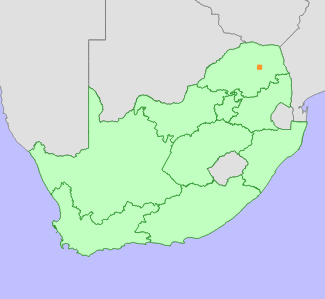|
Scientific Name | Kniphofia crassifolia Baker |
Higher Classification | Monocotyledons |
Family | ASPHODELACEAE |
National Status |
Status and Criteria | Critically Endangered (Possibly Extinct) |
Assessment Date | 2008/04/05 |
Assessor(s) | P.J.D. Winter & L. von Staden |
Justification | Last seen in 1880. More than 80% of the grasslands in the Woodbush area, where this species presumably grew, has been converted to commercial pine plantations since the type collection. Remnant fragments are severely degraded either due to too frequent fire, or to thick infestations of invasive alien plants. If, like many congeners, this species grew in marshy areas, the possibility of its persistence is particularly poor as pine plantations lower the water table in open grassland fragments. Searches in the area have failed to relocated this species. |
Distribution |
Endemism | South African endemic |
Provincial distribution | Limpopo |
Range | Woodbush. |
Habitat and Ecology |
Major system | Terrestrial |
Major habitats | Woodbush Granite Grassland |
Description | Unknown. Quite likely open grassland. |
Threats |
| More than 80% of the grasslands in the Woodbush area, where this species presumably grew, has been converted to commercial pine plantations since the type collection in 1880. Small remaining grassland fragments are severely degraded either due to too frequent burning, or due to thick infestations of alien invasive species (PJD Winter, D McMurtry pers. Comm.) If this species, like many other species of Kniphofia, grew in marshy areas, the outlook for finding it again is particularly poor, as pine plantations are notorious for extracting a lot of water and lowering the water table in open grassland fragments. Searches in the area in the past (Codd 2005) have not yet relocated this species, but another species, Chlorophytum radula, which was also only known from the type collection by Rehmann in 1880 was recently rediscovered in the Woodbush area and adjacent grasslands in the hills south of Tzaneen. |
Population |
Population trend | Unknown |
Assessment History |
Taxon assessed |
Status and Criteria |
Citation/Red List version | | Kniphofia crassifolia Baker | Critically Endangered (Possibly Extinct) | Raimondo et al. (2009) | | Kniphofia crassifolia Baker | Indeterminate | Hilton-Taylor (1996) | | Kniphofia crassifolia Baker | Uncertain | Hall et al. (1980) | |
Bibliography |
Codd, L.E. 2005. Asphodelaceae (First part): Kniphofia. In: G. Germishuizen and B.A. Momberg (eds). Flora of southern Africa 5 Part 1, Fascicle 2:1-91. South African National Biodiversity Institute, Pretoria.
Codd, L.E.W. 1969. The South African species of Kniphofia (Liliaceae). Bothalia 9:363-513.
Hall, A.V., De Winter, M., De Winter, B. and Van Oosterhout, S.A.M. 1980. Threatened plants of southern Africa. South African National Scienctific Programmes Report 45. CSIR, Pretoria.
Hilton-Taylor, C. 1996. Red data list of southern African plants. Strelitzia 4. South African National Botanical Institute, Pretoria.
Raimondo, D., von Staden, L., Foden, W., Victor, J.E., Helme, N.A., Turner, R.C., Kamundi, D.A. and Manyama, P.A. 2009. Red List of South African Plants. Strelitzia 25. South African National Biodiversity Institute, Pretoria.
|
Citation |
| Winter, P.J.D. & von Staden, L. 2008. Kniphofia crassifolia Baker. National Assessment: Red List of South African Plants version 2024.1. Accessed on 2025/11/15 |
 Comment on this assessment
Comment on this assessment


